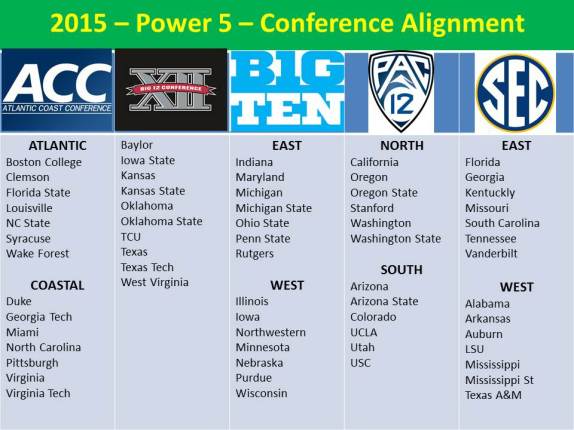In recent years, there has been a lot of shuffling of College Football Conferences. And, if you believe Some Other Dude, there is more yet to come as we advance upon the age of the Mega-Conferences. But, SOD wonders, how well do you know the history of the current Power 5 Conferences?
THE TRIVIA CHALLENGE
Name the original teams in each of the current Power 5 Conferences.
THE BUFFER ZONE
THE ANSWERS
The Atlantic Coast Conference. Even though we appear to be headed to 16 team Mega-Conferences, back in history there was an even mega-er conference; the Southern Conference. The Southern Conference, at one time, consisted of 23 teams and eventually splintered into other, smaller conferences. One of those splinter conferences was the ACC which officially formed as a conference in 1953. The 7 charter members of the ACC were: Clemson, Duke, Maryland, North Carolina, North Carolina State, South Carolina and Wake Forest. Only South Carolina no longer calls the ACC home as they eventually joined the other splinter conference with former Southern Conference brethren. Link to information source.
The Big 12. The history of the Big 12 is a little more convoluted than that of the other conferences. The Big 12 itself wasn’t formed until 1994 when teams from the Big 8 merged with teams from the Southwest Conference. The Big 8 Conference was originally chartered in 1907 as the Missouri Valley Intercollegiate Athletic Association and eventually became known as the Big 6 and then grew up to become the Big 8. The original members of this conference were: Iowa (two-timing with the Big Ten), Kansas, Missouri, Nebraska and Washington University in St. Louis. Only Kansas remains as a current member of The Big 12. Link to information source. The Southwest Conference was first formed in 1912, consisting of: Arkansas, Baylor, Oklahoma, Oklahoma State, Rice, Texas and Texas A&M. Baylor, Oklahoma, Oklahoma State and Texas remain as current members of the Big 12. Link to information source.
The Big Ten. The name “The Big Ten” was actually not officially incorporated until 1987, but the conference referred to as the Big Ten has been around since 1905. The original conference was made up of 7 teams in what was known as the “Intercollegiate Conference Athletic Association”. In 1917, when the conference had expanded to 10 teams, it was labeled the “Big Ten” by members of the media. The original members of this so-called Big Ten Conference were: Indiana, Illinois, Iowa, Michigan, Minnesota, Northwestern, Ohio State, Purdue, University of Chicago and Wisconsin. Only the University of Chicago is not a member of that conference today. Link to information source.
The Pac 12. The Pac 12 Conference started off as a little seedling conference that eventually grew up into the Pac 12. Forming in 1916 as the Pacific Coast Conference, its original members stood at only 4 schools: California, Oregon, Oregon Agricultural College (later known as Oregon State) and Washington. All four schools still remain in the conference today. Interestingly, Idaho and Montana were one time members of this conference and the conference was disbanded and re-assembled in 1959 due to a pay-for-play scandal. The re-formed conference was called the Athletic Association of Western Universities, commonly known as the Big 5. After growing once again, the conference started being referred to as the Pacific 8 in 1964 and officially became the Pacific 8 in 1968, the Pac 10 in 1978 and the Pac 12 in 2011. Link to information source.
The SEC. The SEC preceded the ACC in splintering away from the huge Southern Conference when 13 schools left in 1932 to form their own conference. The 13 schools that made up the first version of the Southeastern Conference were: Alabama, Auburn, Florida, Georgia, Georgia Tech, Kentucky, LSU, Ole Miss, Mississippi State, Sewanee (University of the South), Tennessee, Tulane and Vanderbilt. Georgia Tech now resides in the ACC; Tulane, although still an FBS school is no longer a member of a Power 5 Conference; and, Sewanee, after having decided to de-emphasize sports in 1940, currently competes in Division III athletics. Link to information source.
